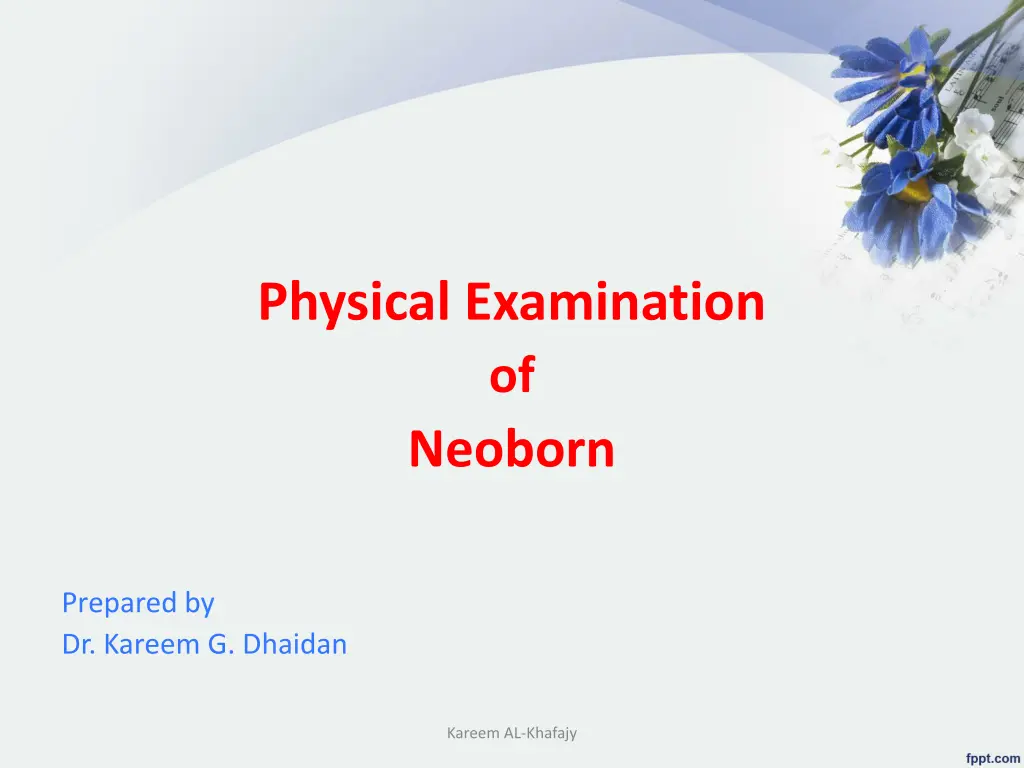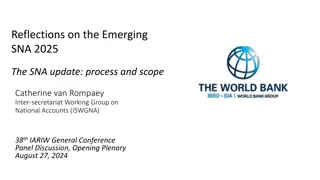
Newborn Physical Examination Essentials by Dr. Kareem G. Dhaidan
Dive into the detailed physical examination of newborns prepared by Dr. Kareem G. Dhaidan, covering vital signs, general appearance, head features, eyes, ears, mouth, throat, neck, and chest characteristics. Understand the crucial aspects of assessing a newborn's health and development to ensure their well-being from the very start.
Download Presentation

Please find below an Image/Link to download the presentation.
The content on the website is provided AS IS for your information and personal use only. It may not be sold, licensed, or shared on other websites without obtaining consent from the author. If you encounter any issues during the download, it is possible that the publisher has removed the file from their server.
You are allowed to download the files provided on this website for personal or commercial use, subject to the condition that they are used lawfully. All files are the property of their respective owners.
The content on the website is provided AS IS for your information and personal use only. It may not be sold, licensed, or shared on other websites without obtaining consent from the author.
E N D
Presentation Transcript
Physical Examination of Neoborn Prepared by Dr. Kareem G. Dhaidan Kareem AL-Khafajy
Vital signs : Axillary temperature: 36.5- 36.6 . Avoid rectal in the first day . Respiration : 30- 60 bpm Pulse : 120- 140 bpm Blood pressure : 65/41 mmHg in the first 3 days. Vital signs must be checked every 2 hours, then once every 8 hours until discharge.
General Appearance : Skin At birth, bright red, puffy, smooth 2nd-3rd day, pink, flaky, dry Vernix caseosa Lanugo Edema around eyes, face, legs, dorsa of hands, feet, and scrotum or labia Acrocyanosis Cyanosis of hands and feet
Head Anterior fontanel Diamond shaped; size varies from barely palpable to 4-5 cm (0.5-2 inches) Posterior fontanel Triangular, 0.5-1 cm (0.2-0.4 inches)
Eyes Lids usually edematous Color Slate gray, dark blue, brown Absence of tears Red reflex Corneal reflex in response to touch Pupillary reflex in response to light Blink reflex in response to light or touch Rudimentary fixation on objects and ability to follow to midline
Ears Position Top of pinna on horizontal line with outer canthus of eye Startle (Moro) reflex elicited by loud, sudden noise or stimulus Pinna flexible, cartilage present Nose Nasal patency Nasal discharge Thin white mucus Sneezing
Mouth and Throat Intact, high-arched palate Uvula in midline Frenulum of tongue Frenulum of upper lip Sucking reflex Strong and coordinated Rooting reflex Gag reflex Extrusion reflex Absent or minimum salivation Vigorous cry
Neck Short, thick, usually surrounded by skinfolds Tonic neck reflex Chest Anteroposterior and lateral diameters equal Slight sternal retractions evident during inspiration Xiphoid process evident Breast enlargement
Lungs Respirations chiefly abdominal Cough reflex absent at birth, present by 1-2 days Bilateral equal bronchial breath sounds
Abdomen Cylindrical in shape Liver Palpable 2-3 cm (0.8-1.8 inches) below right costal margin Spleen Tip palpable at end of 1st week of age Kidneys Palpable 1-2 cm (0.4-0.8 inches) above umbilicus Umbilical cord Bluish white at birth with 2 arteries and 1 vein Femoral pulses Equal bilaterally
Senses: A - Touch: It is the most highly developed sense. It is most acute at lipstongue, ears and forehead. b - Vision:- 1 - Pupils react to light. 2 - Bright lights appear to be unpleasant to newborn infant. 18/06/2025 12
c - Hearing. 1 - The newborn infant usually makes some response to sound from birth. 2 - Ordinary sounds are heard well before 10 days of life. The newborn infant responds to sounds with a cry or eye movement, cessation of activity and / or startle reaction. Kareem AL-Khafajy
d - Taste: well developed as bitter and sour fluids are resisted while sweet fluids are accepted. e - Smell: Only evidence in newborn infant is his search for the nipple as he smells breast milk. Kareem AL-Khafajy
Development: A. Motor Development: 1- His movements are random, diffuse and uncoordinated. 2 - Lackmuscular strength to hold head steady and erect (his head sink down known as head lag). 3 - Bodily functions and responses to external stimuli are carried out by reflexes. Reflexes: The reflexes such as: Moro-reflex, swallowing and gagging reflex. Sucking reflex, grasp reflex , tonic-neck reflex. 18/06/2025 15
B- Cognitive Development: The cognitive (intellectual) development of newborn infant is difficult to understand or observe it. C- Emotional Development: Newborn infant expresses his emotion just through cry for hunger, pain or discomfort sensation. D- Social Development: Cry is his contact with environment; to communicate his physiological needs as hunger, throaty sounds show interest in human face. 18/06/2025 16
References : Wong s nursing care of infants and children / [edited by] Marilyn J. Hockenberry, David Wilson. 10th edition. https://nursekey.com/health-promotion-of-the-newborn-and- family.






















